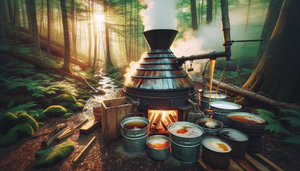Antique Evaporator Technology
Jul 23, 2024
In the heart of Vermont, amidst the serene landscapes and picturesque forests, lies a tradition as sweet and comforting as the first taste of warm maple syrup drizzled over a stack of pancakes. This tradition, deeply rooted in the early technology of evaporators, has revolutionized the boiling process, transforming sap into the liquid gold we cherish today. Let's journey back to the beginnings of this technology, exploring how it has shaped the artisanal craft of maple syrup production.
The Beginnings of Evaporator Technology
The art of making maple syrup dates back centuries, with Native Americans pioneering the process. They would gather sap from maple trees and heat it over open fires to create syrup. However, this method took time and effort. The invention of the evaporator in the 19th century marked a significant turning point.
The first evaporators were simple, rectangular pans made of sheet metal. These pans increased the surface area of the sap, allowing it to boil more quickly and efficiently than the traditional methods. Early evaporators were placed directly over wood fires, utilizing intense heat to speed up evaporation. This reduced the time needed to produce syrup and allowed larger quantities to be processed at once.
Advancements in Evaporator Design
As technology advanced, so did the design of evaporators. By the late 19th century, the efficiency of these devices had improved significantly. Innovations included:
- Arch Design: The introduction of the arch, a brick structure housing the fire beneath the evaporator pans, helped concentrate heat and reduce fuel consumption.
- Flue Pans: These pans featured ridges and channels that increased the surface area, allowing for faster evaporation and more consistent syrup production.
- Sap Preheaters: Preheaters utilize the steam from boiling sap to warm incoming sap, increasing efficiency and reducing energy costs.
These advancements made it possible to produce higher-quality syrup in less time, cementing the role of evaporators in maple syrup production.
The Impact on Maple Syrup Production
The introduction of evaporators revolutionized the boiling process, turning a labor-intensive task into a more manageable and productive operation. This innovation had several key impacts:
- Increased Production: By processing more sap in less time, producers could expand their operations and meet the growing demand for maple syrup.
- Consistency in Quality: Evaporators allowed for better control over the boiling process, resulting in more consistent syrup quality.
- Sustainability: Improved efficiency meant fewer resources were needed, promoting more sustainable production practices.
For maple syrup lovers, these advancements meant a more reliable supply of their favorite sweet treat, crafted with care and tradition.
Modern Evaporators: Bridging Tradition and Technology
Today's evaporators are marvels of engineering, blending tradition with modern technology. Stainless steel constructions, automated controls, and enhanced heat distribution systems ensure the syrup-making process remains efficient and environmentally friendly. Despite these advancements, the core principles remain unchanged: tapping into maple trees' natural sweetness and boiling it to perfection.
The Nostalgic Appeal of Traditional Methods
While modern technology has brought many benefits, there is a growing appreciation for traditional syrup production methods. Many artisanal producers continue to use wood-fired evaporators, embracing the time-honored practices that connect them to the past. This approach honors the history of maple syrup production and creates a unique, rich flavor that connoisseurs cherish.
Frequently Asked Questions
What is an evaporator in maple syrup production? An evaporator is a device that boils sap from maple trees to produce maple syrup. It increases efficiency by spreading the sap over a large surface area.
How did early evaporators improve syrup production? Early evaporators allowed for faster and more efficient sap boiling, reducing the time and labor required and enabling large-scale production.
What are the main components of a traditional evaporator? Traditional evaporators typically include a firebox, arch, and evaporator pans. Some may also have flue pans and sap preheaters for added efficiency.
Why do some producers still use traditional evaporators? Traditional evaporators are cherished for their ability to create a unique flavor and their connection to historical syrup production methods.
The evolution of evaporator technology has played a crucial role in maple syrup production, from the simple pans of the 19th century to the advanced systems used today. This journey not only highlights the ingenuity and dedication of early syrup makers but also underscores the timeless appeal of this beloved tradition. For maple syrup lovers, there is no greater joy than savoring the rich, amber sweetness that connects us to a heritage of craftsmanship and natural beauty.


